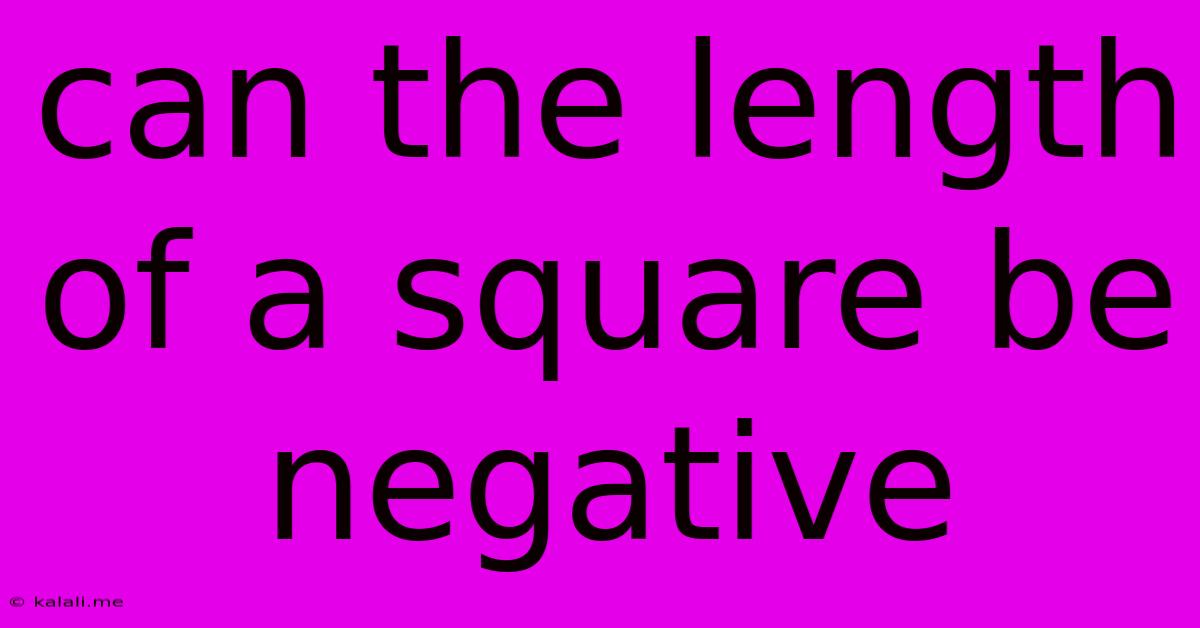Can The Length Of A Square Be Negative
Kalali
Jun 08, 2025 · 3 min read

Table of Contents
Can the Length of a Square Be Negative?
Meta Description: Exploring the mathematical concept of length and its application to squares. We delve into why negative lengths are impossible in the real-world context of geometry.
The question, "Can the length of a square be negative?" might seem simple at first glance. The intuitive answer is a resounding no, and for good reason. Let's explore why this is the case, delving into the fundamental concepts of geometry and the nature of length itself.
Understanding Length and Dimension
Length, in the context of geometry, represents a one-dimensional measure of distance. It quantifies the extent of an object in a single direction. We use length to describe the sides of shapes, the height of objects, and the distance between points. Crucially, length is always considered a positive value or zero. A zero length indicates a point, lacking any extension. The concept of negative length is inherently contradictory to our understanding of physical space.
The Properties of a Square
A square, by definition, is a two-dimensional geometric shape with four equal sides and four right angles. Each side of the square possesses a length, and these lengths are essential to defining the square's properties, such as its area and perimeter. The area, for example, is calculated by multiplying the length of one side by itself (length²). A negative length would lead to an impossible outcome.
Why Negative Length is Impossible
The impossibility of negative length stems from several key reasons:
-
Physical Meaning: Length represents a physical distance. We cannot have a negative distance; it lacks physical interpretation. You can't travel "-5 meters" – you can only travel 5 meters in one direction or 5 meters in the opposite direction.
-
Mathematical Consistency: Negative values introduce inconsistencies in calculations. Imagine trying to calculate the area of a square with a side length of -5 units. The area would be (-5)² = 25 square units, which seems plausible. However, this calculation obscures the inherent contradiction: a negative length doesn't make geometric sense.
-
Coordinate Systems: While coordinate systems utilize negative numbers to represent positions relative to an origin, these negative numbers represent direction and location, not the length itself. The distance between two points, even if represented by coordinates with negative values, is always a positive value.
The Concept of Signed Distance
It's important to distinguish between length and signed distance. Signed distance is used in vector calculations and coordinate systems to indicate direction relative to a reference point. A negative signed distance simply means the direction is opposite to the defined positive direction. However, the magnitude (absolute value) of the signed distance remains positive, representing the actual length.
Conclusion: Length is Always Positive
In conclusion, while negative numbers are essential in many mathematical concepts, they do not apply to the fundamental geometric property of length. The length of a square, or any other geometric object, must always be a non-negative value. The concept of a negative length is mathematically inconsistent and lacks physical meaning within the context of geometry. Therefore, the answer to the question is definitively no.
Latest Posts
Latest Posts
-
Why Wont My Kitten Use The Litter Box
Jun 08, 2025
-
How To Get Rid Of Moss On Bricks
Jun 08, 2025
-
Do I Need Interfaces For Unit Testing
Jun 08, 2025
-
What Purpose Does Hreflang Sitemap Serve
Jun 08, 2025
-
Does The Xbox One Cord Fit Xbox 360
Jun 08, 2025
Related Post
Thank you for visiting our website which covers about Can The Length Of A Square Be Negative . We hope the information provided has been useful to you. Feel free to contact us if you have any questions or need further assistance. See you next time and don't miss to bookmark.